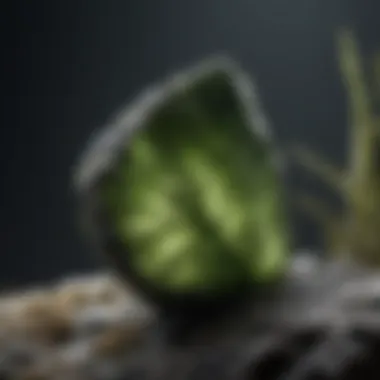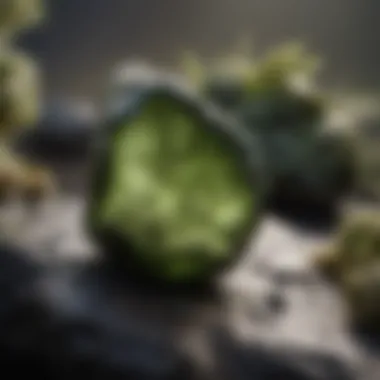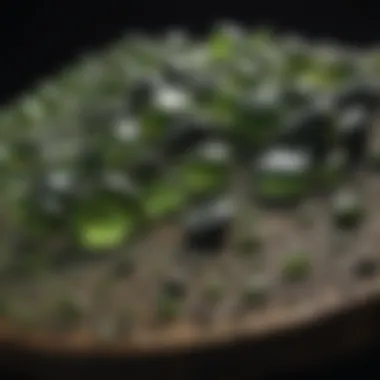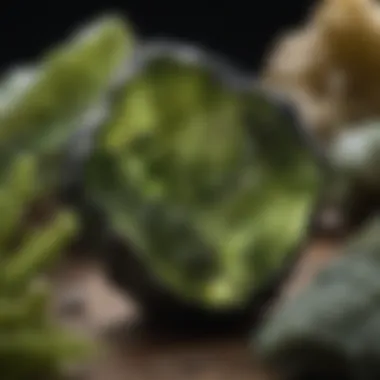Understanding the Cost Factors of Real Moldavite


Intro
Some key aspects to consider when evaluating moldavite include market trends, the legitimacy of the source, and the quality of the piece itself. As interest in moldavite grows, so does the need for informed buying decisions. This guide aims to equip collectors with necessary insights to navigate the complexities of moldavite pricing, ensuring a more successful collection journey.
Intro to Moldavite
Moldavite is a fascinating gemstone that captures the interest of collectors and enthusiasts alike. Its unique origins as a result of a meteorite impact contribute to its allure. Understanding moldavite is crucial for anyone considering diving into this market, as it provides insight into its history, formation, and distinct characteristics. These elements not only help collectors appreciate the stone, but they also impact the valuation and authenticity of the piece.
Historical Context
Moldavite's history is rooted in the event that created it. Approximately 15 million years ago, a meteor struck the Earth near the region of the Moldau River in what is now the Czech Republic. This high-energy collision melted the surrounding silica-rich rocks, which then combined with the meteorite material. As it cooled, moldavite was formed. Its unique green color is one of the few characteristics that distinguish moldavite from other stones. Historically, moldavite was used by ancient civilizations, including the Celts, who believed it possessed mystical properties. This historical significance has propelled moldavite into the realm of sacred gemstones, making it a desirable item for those interested in both its origins and its purported metaphysical qualities.
Geological Formation
The geological formation of moldavite involves more than just its creation from impacts. The specific conditions of the impact played a significant role in how moldavite emerged. The process involves liquefaction, where extreme heat turns rock and metal into molten glass. Upon cooling, the resultant glass can form beautiful pieces that are shaped by the forces of nature. Moldavite's formation is classified as tektite, a type of natural glass formed from terrestrial debris ejected during impacts. This geological background adds another layer to understand its rarity and value, as moldavite is only found in specific locations, providing a limited supply.
In summary, the historical context and geological formation of moldavite enrich its narrative. Appreciating these facets allows collectors to understand why moldavite holds its place among valuable gemstones and how its unique qualities contribute to its price on the market.
Factors Affecting Moldavite Pricing
Understanding the pricing of moldavite involves several critical factors that can influence its value in the market. Moldavite, being a gemstone that originates from a unique geological event, involves complexity not common to other stones. For collectors and investors alike, grasping how these factors interplay is essential for making informed purchasing decisions. By focusing on the qualities of the stone, its size and weight, as well as its origin and market demand, one can identify fair pricing and avoid overpaying for pieces that may not hold their value over time.
Quality of the Stone
Clarity and Transparency
Clarity and transparency are vital components when assessing moldavite. Cloarly defined stones that boast high transparency are in greater demand. A clear moldavite allows light to pass through, enhancing its visual appeal. Most collectors seek pieces that exhibit minimal flaws. On the flip side, stones with lower transparency may appear dull, reducing their desirability.
A unique feature of clarity is its direct impact on beauty and therefore cost. Moldavite with high clarity often commands a higher price, showcasing its natural beauty. However, it is important to note that high-clarity stones can sometimes appear less interesting due to a lack of character from inclusions. This makes it essential for collectors to consider their personal preferences when evaluating clarity.
Color Variations
Color variations contribute significantly to the allure of moldavite. The stone can range from light green to deep shades, each bringing its own value and appeal. Collectors often favor deeper shades, as they are considered rarer. These rich colors are believed to have more intense energy, which may be attractive to those interested in the metaphysical aspects of the stone.
A key characteristic of color pricing is its relation to saturation and hue. The saturation of color can greatly impact the price of individual stones. Collectors should understand the specific shade and its popularity among enthusiasts. Finding a balance between unique colors and overall desirability can guide potential buyers effectively.
Inclusions and Bubbles
Inclusions and bubbles can provide interesting aspects to moldavite. Some collectors appreciate the presence of inclusions as they offer insight into the stone's history and origin. Unique formations can set a piece apart and may even increase its value in niche markets. However, this is complex. Stones with noticeable bubbles can be perceived as flawed and may see a drop in price.
What makes this topic relevant is the wide range in preferences among collectors. Buyers should weigh the advantages of unique inclusions against the potential downsides, as price differs with individual perspective. Collectors often seek specific inclusions that resonate with them personally.
Size and Weight
Carat Weight Considerations
Carat weight directly affects the pricing of moldavite. Generally, larger stones attract premium prices. This correlation between size and price stems from the increasing rarity of larger specimens. Many collectors utilize this weight as a key metric for valuing stones.


A beneficial aspect of understanding carat weight is its straightforwardness. It allows an easy comparison between specimens. For collectors, knowing the average price per carat helps in recognizing whether a stone is overpriced based on its weight. However, larger stones also come with a downside. While they can be visually impressive, they may lack the unique character smaller stones can have, and this is an aspect collectors must contemplate.
Rarity of Larger Specimens
Larger moldavite specimens are significantly rarer in the market. Their rarity inspires a premium on their price. Collectors often pursue these larger pieces due to the statement they make. A large moldavite can be a striking focal point of a collection.
However, this rarity can also create challenges. As the size increases, the likelihood of flaws being visible also rises. It is important for buyers to seek precision in their collecting approach. Focusing solely on size without considering other quality factors can lead to regrettable purchases. Be prepared to spend more for larger specimens, as their rarity inevitably inflates values.
Origin and Authenticity
Source of the Moldavite
The origin of a moldavite significantly influences its market value. Authentic moldavite can only be sourced from specific locations in the Czech Republic. This exclusivity adds to its allure for collectors. Moldavite sourced from these historic sites is often deemed more desirable and carries a higher price tag.
Understanding the source is beneficial for both collectors and investors. It enables them to verify authenticity and determines potential value. The unique features of moldavite from different areas may offer distinct characteristics that appeal to niche collectors or markets. However, buyers must exercise caution; there are imitations available on the market that lack genuine origin.
Certification and Provenance
Certification serves as a cornerstone in establishing authenticity. Possessing an official certificate can enhance a piece's marketability and value. Stones that come with certificates from reputable gemological laboratories tend to fetch higher prices.
The importance of provenance cannot be understated. Provenance refers to the documented history of ownership, which can add or detract from a stone's perceived worth. Buyers should look for reputable sources and documentation. Not all certificates carry equal weight, so it is essential to choose wisely.
Market Demand
Trends in Collecting
Trends greatly affect market demand for moldavite. The growing interest in alternative healing and collectibles has increased the desirability of this stone. Awareness in both physical and virtual settings continues to rise. Collectors often look for unique pieces to enrich their collections.
A key observation of market trends is their cyclical nature. What is popular now may shift rapidly, impacting pricing. Keeping informed allows collectors to make educated decisions and potentially capitalize on favorable trends. Being engaged with community platforms like Reddit can provide insights into current trends and preferences.
The Role of Online Marketplaces
Online marketplaces have transformed how collectors access moldavite. Platforms such as eBay and Etsy present both opportunities and pitfalls. Buyers can find a wider selection than ever; however, they must be vigilant in distinguishing between genuine and fake offerings.
The benefits of online shopping include convenience and competitive pricing. Knowledgeable collectors can utilize various resources to compare prices and obtain deals. Yet, the challenges of navigating these environments call for vigilant research and patience. As the online marketplace grows, it is essential to rely on trusted vendors and communities for support.
Understanding these factors affecting moldavite pricing offers a clearer perspective for collectors navigating the market. This insight forms a strong foundation for making informed decisions while considering both the aesthetic appeal and investment potential of moldavite.
Evaluating Moldavite Prices
Evaluating moldavite prices is an essential aspect of understanding the market for this unique gemstone. The accuracy of pricing can greatly inform both novice and expert collectors. Knowledge of the pricing evaluation process helps buyers make informed decisions. It also arms them against overspending or getting scammed, which is crucial in a market filled with both genuine and fake stones.
Prices can vary due to several factors, but two broad categories stand out: comparative pricing and understanding valuation myths. Comparative pricing reveals the current market rates while highlighting the variations from seller to seller. Understanding valuation myths breaks down common misconceptions that could skew perceptions of moldavite’s worth. Being able to sift through this noise aids customers in identifying true value versus inflated claims.
Comparative Pricing
Current Market Rates
Current market rates provide insight into what one can expect to pay for moldavite today. This aspect is important because it represents a baseline for collectors. Market rates reflect various factors like size, quality, and authenticity. Typically, prices per gram or carat are common ways to express the cost. As of late 2023, premium moldavite pieces can range from $50 to over $500 per gram depending on their quality and rarity.


One key characteristic of current market rates is that they are indicative of immediate demand. In a fluctuating market, staying updated with these rates can guide purchasing decisions effectively. It highlights the relative value associated with moldavite at any moment, helping collectors set budgets and make offers based on factual data.
However, prices can fluctuate due to trends and availability, which are both advantages and disadvantages. Buyers might find a great deal, or they could face inflated prices during a surge in popularity.
Variability from Seller to Seller
Variability from seller to seller is another critical aspect of moldavite pricing. This variability can come from differences in pricing strategy, perceived value, and even geographical locations. It contributes to the overall understanding by showcasing how much discretion sellers have in establishing their prices.
A major characteristic of this variability is the potential for significant price differences. While some sellers may price their pieces at a premium due to marketing or perceived prestige, others may sell similar items at lower rates. This can be beneficial for savvy shoppers who do their research, as it provides opportunities for finding high-quality items at lower prices.
Yet, this variability also has disadvantages. With this diversity in pricing, it can be easy to confuse fair market value with inflated interests that are driven by seller biases or trends.
Understanding Valuation Myths
Myths about Rarity
Myths about rarity play a significant role in how moldavite is valued. Many believe that the stone's scarcity automatically dictates its worth. While moldavite is indeed rare, the perception of its rarity often overshadows actual market value. Some collectors pay exorbitant prices based on the belief that all moldavite is inherently valuable just because it is rare.
This is a misconception. While rarity contributes to the value, other factors such as clarity, size, and market trends are equally critical. This myth can mislead buyers who may not have deep knowledge of what truly influences price.
Misconceptions about Spiritual Value
Misconceptions about spiritual value can also distort moldavite pricing. Many collectors attribute a higher spiritual significance to moldavite, believing that it carries energy or healing properties that increase its worth. While these qualities are often touted in various communities, they can create inflated pricing.
This aspect is crucial for rational evaluation, allowing collectors to discern between anecdotal beliefs and actual gemstone value. It is important to approach these claims with a healthy skepticism. Buyers should recognize that while spiritual experiences can be personal, they should not solely dictate market value.
In summary, evaluating moldavite prices encompasses a range of factors that can significantly impact the buying decision. Knowledge of market rates, seller variability, myths of rarity, and misconceptions about spiritual value are critical elements in helping collectors navigate this complex market.
Where to Purchase Moldavite
Purchasing real moldavite requires careful consideration of sources to ensure authenticity and fair pricing. Understanding where to buy is essential for collectors, whether they are novice or seasoned. This section will explore the best places to acquire moldavite and highlight various factors that contribute to a successful purchase experience.
Reputable Vendors
Online Marketplaces
Online marketplaces have become a popular choice for collectors looking to purchase moldavite. One notable aspect of these platforms is their vast selection. Websites like eBay, Etsy, or specialized gem retailers often offer a range of moldavite pieces varying in size, quality, and price.
A key characteristic of online marketplaces is the ability to compare prices and attributes across multiple sellers quickly. This can be a time-saving advantage for buyers seeking the best deal. Another aspect to consider is customer reviews. Positive feedback can provide an additional layer of trust when making a purchase. Still, buyers must remain vigilant against misleading listings.
While online marketplaces offer convenience and variety, they also come with disadvantages. The risk of purchasing fake moldavite is notably higher. Lack of direct interaction with the seller may prevent buyers from fully inspecting the product before finalizing the purchase.
Local Gem Shows
Local gem shows are an alternative and beneficial choice for purchasing moldavite. These events allow collectors to examine the stones in-person, which enhances the buying experience. Local shows usually feature gem and mineral vendors who can provide firsthand knowledge about their products.
A key benefit of attending gem shows is the opportunity for direct negotiation. Collectors can often discuss pricing with vendors, potentially leading to better deals compared to fixed online prices. Additionally, buying locally supports small businesses and the gem community.
However, local gem shows can also have limitations. The selection may not be as wide as online platforms, depending on the size of the event. Moreover, the frequency of these shows varies by region, which may affect accessibility for some collectors.


Red Flags to Watch For
Identifying potential scams and ensuring genuine purchases is crucial in the moldavite market. Certain red flags should be closely scrutinized to safeguard against issues.
Signs of Fake Moldavite
Signs of fake moldavite are vital to recognize for a safe purchase. One prominent sign is the weight of the stone. Authentic moldavite is relatively lightweight, while replicas tend to be heavier. Color and texture also play a role; real moldavite exhibits natural inclusions and a distinctive texture.
Being familiar with these signs is a beneficial approach. It can prevent misinformed purchases that could lead to disappointment or financial loss.
Questionable Pricing Tactics
Another aspect to consider is pricing tactics that may appear suspicious. Extremely low prices may indicate a lack of authenticity. If a seller lists moldavite at fraction of common market rates, this should raise concerns. Transparency in pricing from reputable vendors is crucial.
Buyers should always ensure that the price reflects the quality and characteristics of the stone. Recognizing these pricing tactics can empower buyers to make more informed decisions.
Caring for Your Moldavite Collection
Caring for moldavite is crucial due to its unique properties and value. As a collector, understanding the ways to preserve and protect this extraordinary gemstone can ensure its beauty and longevity. Moldavite is not just an object of fascination but also a piece of history, formed from a rare geological event. Therefore, the responsibility of its maintenance lies with you, the owner. Here, we will explore the appropriate techniques for preserving moldavite and how to store it safely to mitigate risks of damage.
Preservation Techniques
To keep your moldavite in good condition, it’s essential to employ specific preservation techniques. First, always handle moldavite with clean hands. Oils and dirt can affect the surface. If cleaning is necessary, use a soft, damp cloth to gently wipe the stone. Avoid commercial cleaners as they can be too harsh and may lead to abrasion.
Another technique is to avoid direct sunlight. Prolonged exposure can fade the color and detract from its luster. Instead, store moldavite in a shady area or in an enclosure that protects it from UV rays. Furthermore, temperature fluctuations are detrimental to moldavite. It is advisable to maintain a stable environment to prevent cracks or changes in structure.
Moldavite is sensitive to temperature changes and prolonged sunlight exposure. Appropriate care can ensure its long-term beauty and durability.
Storing Moldavite Safely
When it comes to storage, several considerations are essential to protect your moldavite. Use a soft pouch or a dedicated jewelry box lined with fabric to cushion the stone. This reduces the risk of scratches or impacts from other objects.
Avoid keeping moldavite with harder gemstones or metals as they can cause damage. Ideally, store each piece separately to ensure they don’t touch one another. Additionally, consider humidity levels. A dry environment is preferable as moisture can lead to unwanted growth and deterioration over time.
For those who travel with their moldavite, use a secure travel case. Inserts that hold the stones in place can prevent movement and potential breakage.
Culmination
Summarizing Key Points
In summary, the cost of real moldavite is determined by various factors, including the quality of the stone, its size and weight, origin and authenticity, as well as market demand. Each aspect contributes to the overall price and is essential for collectors to understand.
- Quality of the Stone: Clarity, color variations, and any inclusions play a crucial role.
- Size and Weight: Larger specimens often command higher prices due to their rarity.
- Origin: Authenticity and provenance influence buyer confidence.
- Market Demand: Trends can shift rapidly, impacting how moldavite is valued at any given time.
Equipped with this understanding, buyers can avoid common pitfalls and engage in more informed negotiations.
Future Market Considerations
Looking ahead, the moldavite market is expected to evolve. Several trends may affect future pricing:
- Increased Interest: With growing awareness of moldavite, interest could rise among collectors.
- Sustainable Sourcing: As collectors becoime more socially conscious, sourcing authenticity will become more significant.
- Technological Impact: Online platforms may reshape how buyers access moldavite, leading to changes in valuation and demand.
Buyers should always stay informed about these shifts to navigate the complexities of moldavite pricing.
Understanding these elements provides an advantage in the evolving landscape of moldavite collecting. Being informed allows collectors to make decisions that not only fulfill their passions but also protect their investments.



